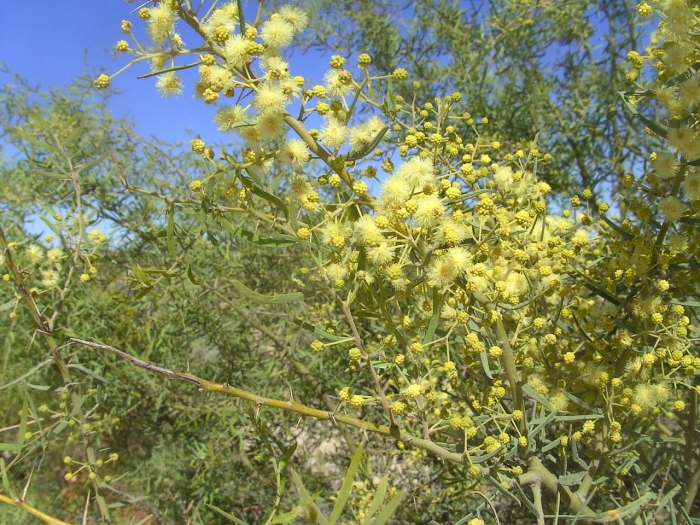Bardi Bush
(Acacia victoriae)
Bardi Bush (Acacia victoriae)
/
/

Ian Sutton
CC BY 2.0
Image By:
Ian Sutton
Recorded By:
Copyright:
CC BY 2.0
Copyright Notice:
Photo by: Ian Sutton | License Type: CC BY 2.0 | License URL: https://creativecommons.org/licenses/by/2.0 | Uploader: Flickr upload bot | Publisher: Wikimedia Commons | Title: Elegant_Wattle,_Prickly_Wattle,_Gundabluie.jpg | Notes: |





























Estimated Native Range
Summary
Acacia victoriae, commonly known as Bardi Bush, is a shrub-like tree native to arid and semi-arid regions of Australia, particularly thriving in open woodlands and scrublands. This species is well-adapted to its harsh native environment, often found on sandy or rocky soils. Mature plants typically reach a height of 5–6 meters with a multi-trunked habit, and they exhibit moderate growth rates. Acacia victoriae has a relatively short lifespan of 10–15 years but compensates with a large root system that can extend up to 20 meters, enabling it to access deep water reserves and survive periods of drought, though it may struggle in severe drought conditions. It can regenerate from suckers, which aids in its recovery from environmental stress.
The Bardi Bush is notable for its defensive spines, approximately 1 cm in length, which cover its branches. Flowering occurs from August to late December, varying by region, and is followed by the development of seeds. The flowers are yellow, clustered, and strongly scented, attracting pollinators and providing shelter for birds and small mammals. In cultivation, Acacia victoriae is valued for its windbreak capabilities and soil stabilization properties, as well as for site rehabilitation due to its moderate growth rate. It requires full sun exposure and can tolerate low to medium water availability, thriving in soils with slow to medium drainage. While it is not commonly afflicted by diseases, its extensive root system can potentially interfere with nearby structures or plumbing if not managed properly. Gardeners should be aware of its spiny nature when planting in areas frequented by people or pets.CC BY-SA 4.0
The Bardi Bush is notable for its defensive spines, approximately 1 cm in length, which cover its branches. Flowering occurs from August to late December, varying by region, and is followed by the development of seeds. The flowers are yellow, clustered, and strongly scented, attracting pollinators and providing shelter for birds and small mammals. In cultivation, Acacia victoriae is valued for its windbreak capabilities and soil stabilization properties, as well as for site rehabilitation due to its moderate growth rate. It requires full sun exposure and can tolerate low to medium water availability, thriving in soils with slow to medium drainage. While it is not commonly afflicted by diseases, its extensive root system can potentially interfere with nearby structures or plumbing if not managed properly. Gardeners should be aware of its spiny nature when planting in areas frequented by people or pets.CC BY-SA 4.0
Plant Description
- Plant Type: Shrub
- Height: 15-25 feet
- Width: 15-25 feet
- Growth Rate: Rapid
- Flower Color: Cream, Yellow
- Flowering Season: Winter, Spring
- Leaf Retention: Evergreen
Growth Requirements
- Sun: Full Sun
- Water: Low, Medium
- Drainage: Slow, Medium
Common Uses
Bee Garden, Bird Garden, Drought Tolerant, Edible*Disclaimer: Easyscape's listed plant edibility is for informational use. Always verify the safety and proper identification of any plant before consumption., Hummingbird Garden, Low Maintenance
Natural Habitat
Native to arid and semi-arid regions, open woodlands, and scrublands in Australia
Other Names
Common Names: Gundabluie, Graceful Wattle, Acacia-Bush, Bramble Acacia, Bramble Wattle, Royal Acacia, Pinbush, Prickly Wattle, Elegant Wattle
Scientific Names: , Acacia victoriae, Acacia sentis, Acacia sentis var. victoriae, Racosperma victoriae,
GBIF Accepted Name: Acacia victoriae Benth.